Organisational Behaviour Report: Apple Inc. Analysis, Motivation
VerifiedAdded on 2023/01/12
|18
|4928
|88
Report
AI Summary
This report provides an in-depth analysis of organisational behaviour, specifically examining the influence of power, politics, and culture on team behaviour and individual performance within Apple Inc. It delves into various aspects of organisational culture, including power, task, person, and role cultures, and their impact on employee behaviour. The report also explores the importance of cultural variation awareness, utilising Hofstede's model to analyse cultural dimensions. Furthermore, it investigates the role of organisational politics and power dynamics, highlighting how they affect employee outcomes. The report then shifts its focus to motivation, discussing both process and content theories, along with motivational techniques to achieve organisational goals. It also examines Maslow's Hierarchy of Needs and other motivational theories. Finally, it differentiates between effective and ineffective teams, and analyzes team development theories to support dynamic cooperation. The report concludes by presenting concepts and philosophies of organisational behaviour in the context of Apple Inc.'s business situation, including the application of path-goal theory.
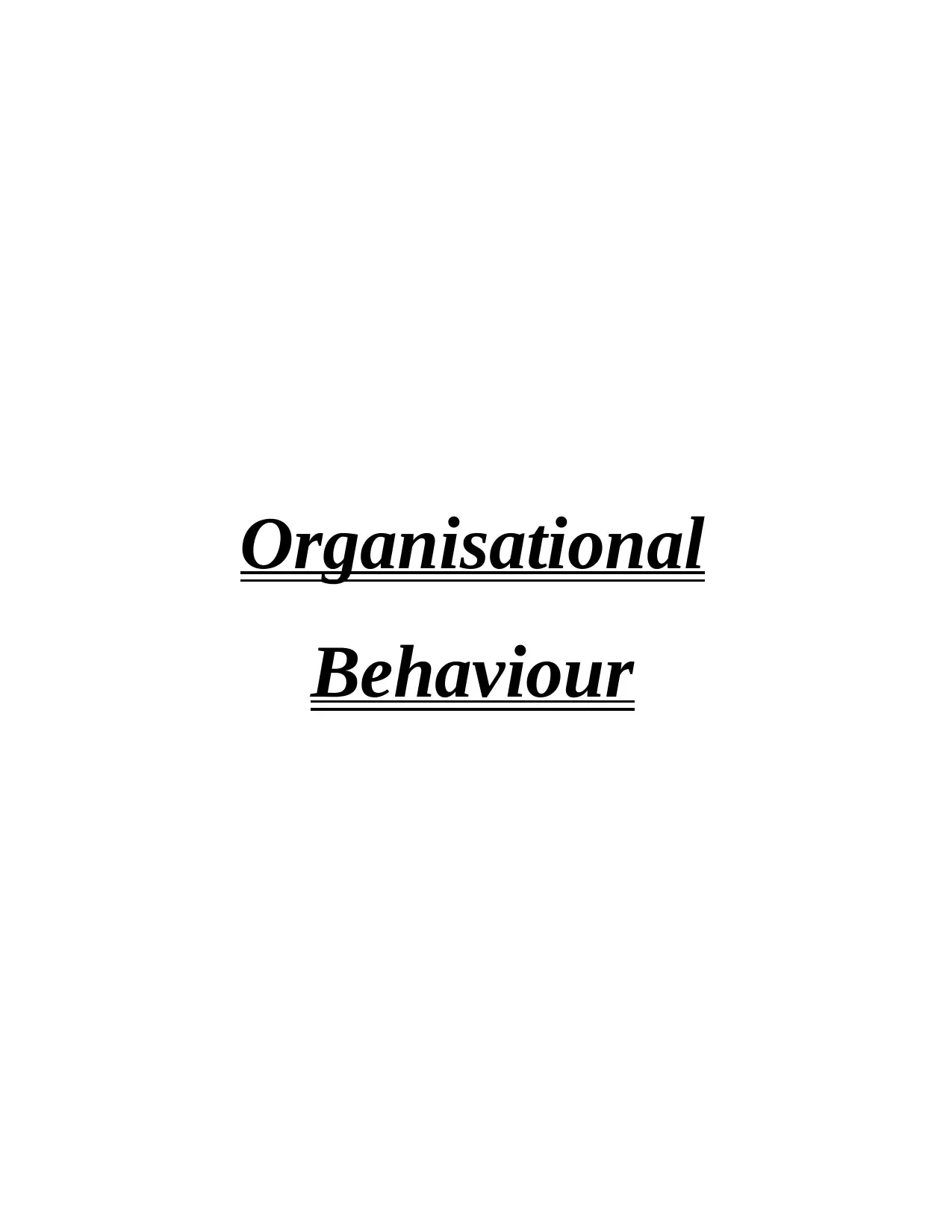
Organisational
Behaviour
Behaviour
Paraphrase This Document
Need a fresh take? Get an instant paraphrase of this document with our AI Paraphraser
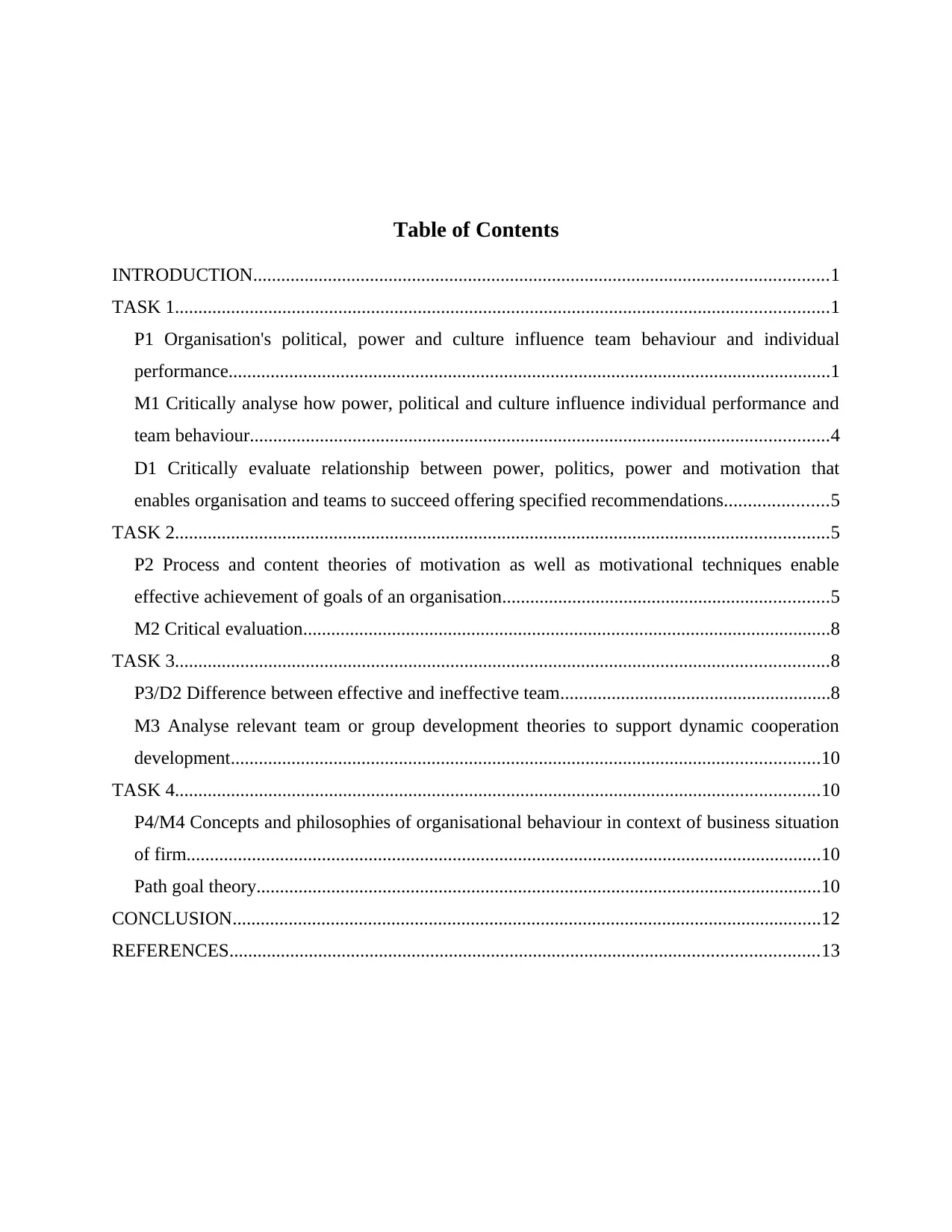
Table of Contents
INTRODUCTION...........................................................................................................................1
TASK 1............................................................................................................................................1
P1 Organisation's political, power and culture influence team behaviour and individual
performance.................................................................................................................................1
M1 Critically analyse how power, political and culture influence individual performance and
team behaviour............................................................................................................................4
D1 Critically evaluate relationship between power, politics, power and motivation that
enables organisation and teams to succeed offering specified recommendations......................5
TASK 2............................................................................................................................................5
P2 Process and content theories of motivation as well as motivational techniques enable
effective achievement of goals of an organisation......................................................................5
M2 Critical evaluation.................................................................................................................8
TASK 3............................................................................................................................................8
P3/D2 Difference between effective and ineffective team..........................................................8
M3 Analyse relevant team or group development theories to support dynamic cooperation
development..............................................................................................................................10
TASK 4..........................................................................................................................................10
P4/M4 Concepts and philosophies of organisational behaviour in context of business situation
of firm........................................................................................................................................10
Path goal theory.........................................................................................................................10
CONCLUSION..............................................................................................................................12
REFERENCES..............................................................................................................................13
INTRODUCTION...........................................................................................................................1
TASK 1............................................................................................................................................1
P1 Organisation's political, power and culture influence team behaviour and individual
performance.................................................................................................................................1
M1 Critically analyse how power, political and culture influence individual performance and
team behaviour............................................................................................................................4
D1 Critically evaluate relationship between power, politics, power and motivation that
enables organisation and teams to succeed offering specified recommendations......................5
TASK 2............................................................................................................................................5
P2 Process and content theories of motivation as well as motivational techniques enable
effective achievement of goals of an organisation......................................................................5
M2 Critical evaluation.................................................................................................................8
TASK 3............................................................................................................................................8
P3/D2 Difference between effective and ineffective team..........................................................8
M3 Analyse relevant team or group development theories to support dynamic cooperation
development..............................................................................................................................10
TASK 4..........................................................................................................................................10
P4/M4 Concepts and philosophies of organisational behaviour in context of business situation
of firm........................................................................................................................................10
Path goal theory.........................................................................................................................10
CONCLUSION..............................................................................................................................12
REFERENCES..............................................................................................................................13

⊘ This is a preview!⊘
Do you want full access?
Subscribe today to unlock all pages.

Trusted by 1+ million students worldwide

Paraphrase This Document
Need a fresh take? Get an instant paraphrase of this document with our AI Paraphraser
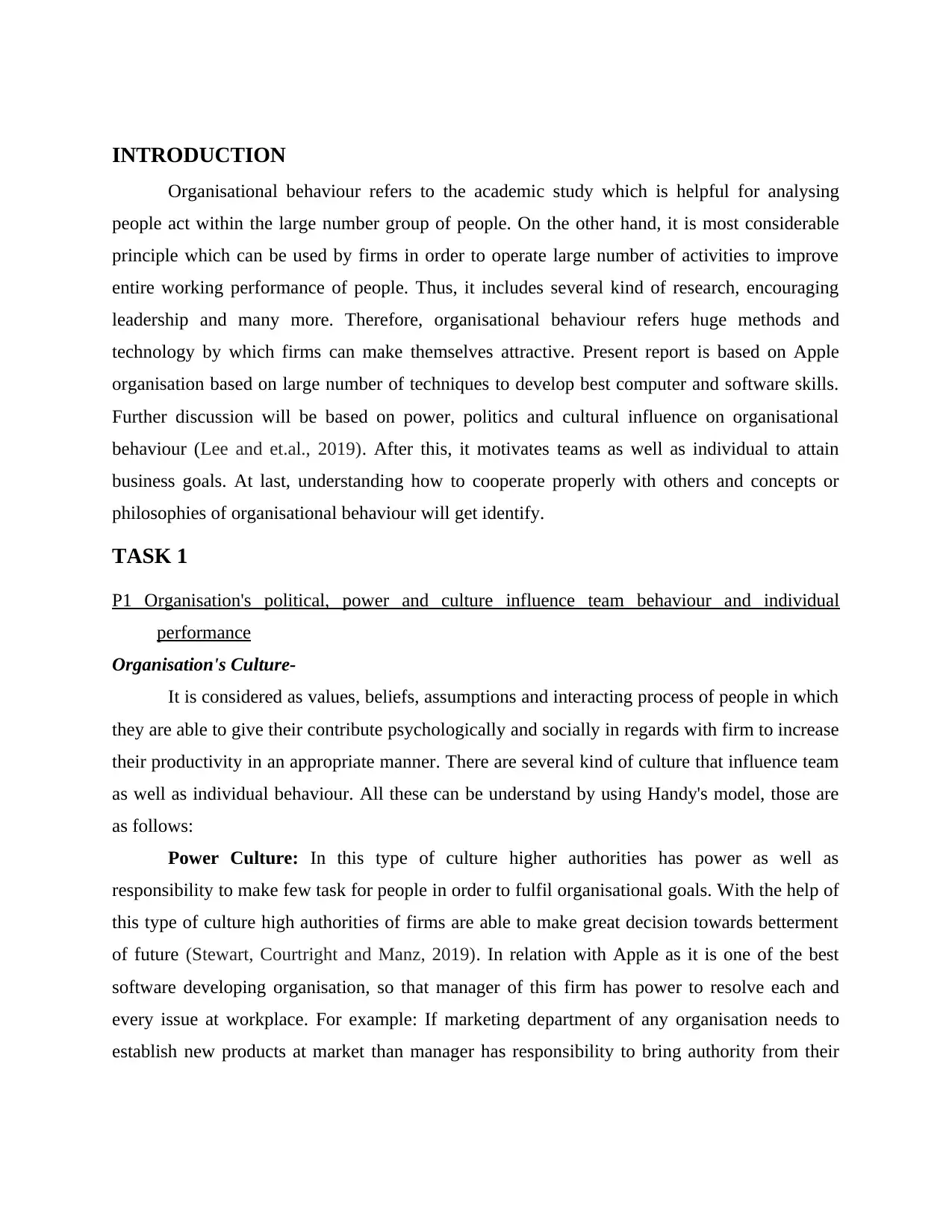
INTRODUCTION
Organisational behaviour refers to the academic study which is helpful for analysing
people act within the large number group of people. On the other hand, it is most considerable
principle which can be used by firms in order to operate large number of activities to improve
entire working performance of people. Thus, it includes several kind of research, encouraging
leadership and many more. Therefore, organisational behaviour refers huge methods and
technology by which firms can make themselves attractive. Present report is based on Apple
organisation based on large number of techniques to develop best computer and software skills.
Further discussion will be based on power, politics and cultural influence on organisational
behaviour (Lee and et.al., 2019). After this, it motivates teams as well as individual to attain
business goals. At last, understanding how to cooperate properly with others and concepts or
philosophies of organisational behaviour will get identify.
TASK 1
P1 Organisation's political, power and culture influence team behaviour and individual
performance
Organisation's Culture-
It is considered as values, beliefs, assumptions and interacting process of people in which
they are able to give their contribute psychologically and socially in regards with firm to increase
their productivity in an appropriate manner. There are several kind of culture that influence team
as well as individual behaviour. All these can be understand by using Handy's model, those are
as follows:
Power Culture: In this type of culture higher authorities has power as well as
responsibility to make few task for people in order to fulfil organisational goals. With the help of
this type of culture high authorities of firms are able to make great decision towards betterment
of future (Stewart, Courtright and Manz, 2019). In relation with Apple as it is one of the best
software developing organisation, so that manager of this firm has power to resolve each and
every issue at workplace. For example: If marketing department of any organisation needs to
establish new products at market than manager has responsibility to bring authority from their
Organisational behaviour refers to the academic study which is helpful for analysing
people act within the large number group of people. On the other hand, it is most considerable
principle which can be used by firms in order to operate large number of activities to improve
entire working performance of people. Thus, it includes several kind of research, encouraging
leadership and many more. Therefore, organisational behaviour refers huge methods and
technology by which firms can make themselves attractive. Present report is based on Apple
organisation based on large number of techniques to develop best computer and software skills.
Further discussion will be based on power, politics and cultural influence on organisational
behaviour (Lee and et.al., 2019). After this, it motivates teams as well as individual to attain
business goals. At last, understanding how to cooperate properly with others and concepts or
philosophies of organisational behaviour will get identify.
TASK 1
P1 Organisation's political, power and culture influence team behaviour and individual
performance
Organisation's Culture-
It is considered as values, beliefs, assumptions and interacting process of people in which
they are able to give their contribute psychologically and socially in regards with firm to increase
their productivity in an appropriate manner. There are several kind of culture that influence team
as well as individual behaviour. All these can be understand by using Handy's model, those are
as follows:
Power Culture: In this type of culture higher authorities has power as well as
responsibility to make few task for people in order to fulfil organisational goals. With the help of
this type of culture high authorities of firms are able to make great decision towards betterment
of future (Stewart, Courtright and Manz, 2019). In relation with Apple as it is one of the best
software developing organisation, so that manager of this firm has power to resolve each and
every issue at workplace. For example: If marketing department of any organisation needs to
establish new products at market than manager has responsibility to bring authority from their
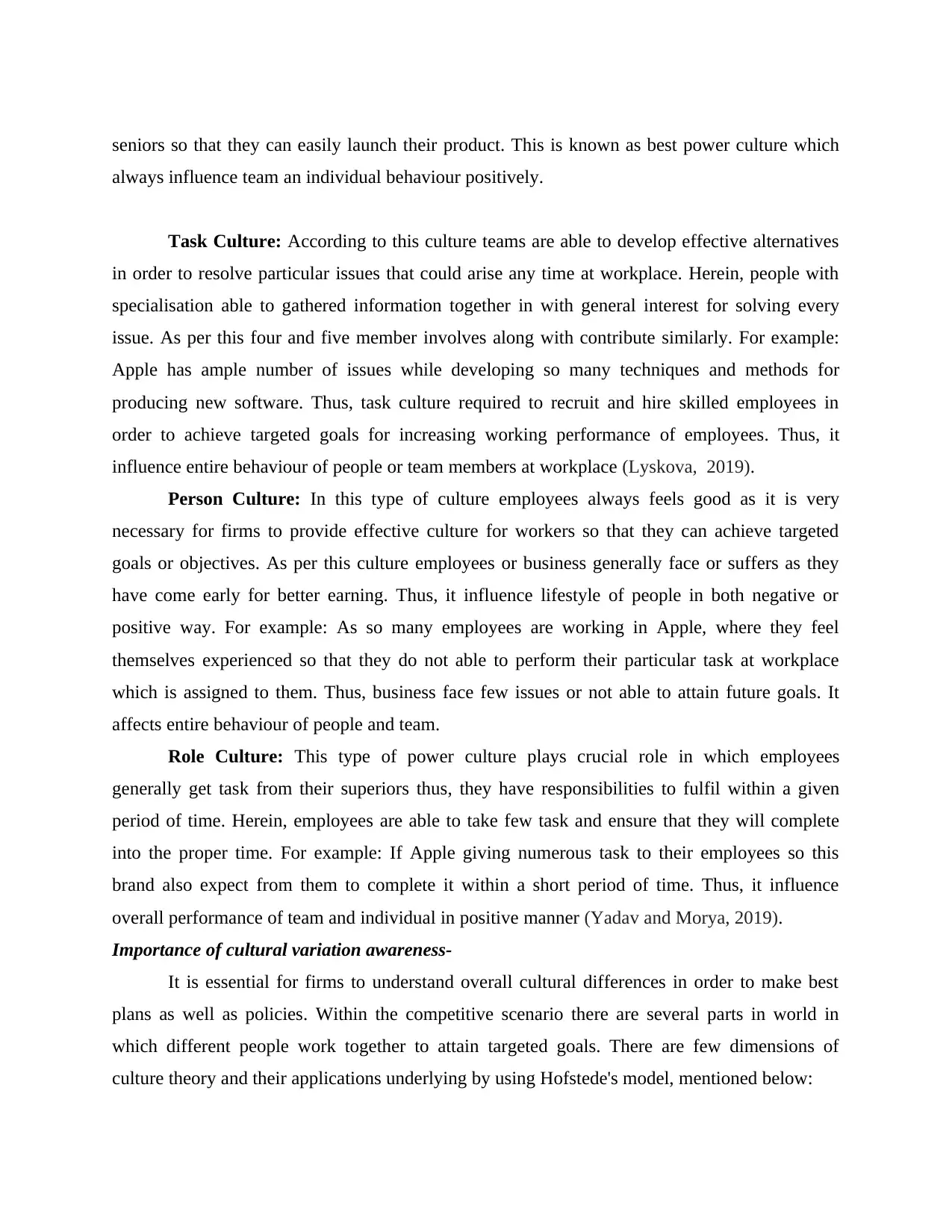
seniors so that they can easily launch their product. This is known as best power culture which
always influence team an individual behaviour positively.
Task Culture: According to this culture teams are able to develop effective alternatives
in order to resolve particular issues that could arise any time at workplace. Herein, people with
specialisation able to gathered information together in with general interest for solving every
issue. As per this four and five member involves along with contribute similarly. For example:
Apple has ample number of issues while developing so many techniques and methods for
producing new software. Thus, task culture required to recruit and hire skilled employees in
order to achieve targeted goals for increasing working performance of employees. Thus, it
influence entire behaviour of people or team members at workplace (Lyskova, 2019).
Person Culture: In this type of culture employees always feels good as it is very
necessary for firms to provide effective culture for workers so that they can achieve targeted
goals or objectives. As per this culture employees or business generally face or suffers as they
have come early for better earning. Thus, it influence lifestyle of people in both negative or
positive way. For example: As so many employees are working in Apple, where they feel
themselves experienced so that they do not able to perform their particular task at workplace
which is assigned to them. Thus, business face few issues or not able to attain future goals. It
affects entire behaviour of people and team.
Role Culture: This type of power culture plays crucial role in which employees
generally get task from their superiors thus, they have responsibilities to fulfil within a given
period of time. Herein, employees are able to take few task and ensure that they will complete
into the proper time. For example: If Apple giving numerous task to their employees so this
brand also expect from them to complete it within a short period of time. Thus, it influence
overall performance of team and individual in positive manner (Yadav and Morya, 2019).
Importance of cultural variation awareness-
It is essential for firms to understand overall cultural differences in order to make best
plans as well as policies. Within the competitive scenario there are several parts in world in
which different people work together to attain targeted goals. There are few dimensions of
culture theory and their applications underlying by using Hofstede's model, mentioned below:
always influence team an individual behaviour positively.
Task Culture: According to this culture teams are able to develop effective alternatives
in order to resolve particular issues that could arise any time at workplace. Herein, people with
specialisation able to gathered information together in with general interest for solving every
issue. As per this four and five member involves along with contribute similarly. For example:
Apple has ample number of issues while developing so many techniques and methods for
producing new software. Thus, task culture required to recruit and hire skilled employees in
order to achieve targeted goals for increasing working performance of employees. Thus, it
influence entire behaviour of people or team members at workplace (Lyskova, 2019).
Person Culture: In this type of culture employees always feels good as it is very
necessary for firms to provide effective culture for workers so that they can achieve targeted
goals or objectives. As per this culture employees or business generally face or suffers as they
have come early for better earning. Thus, it influence lifestyle of people in both negative or
positive way. For example: As so many employees are working in Apple, where they feel
themselves experienced so that they do not able to perform their particular task at workplace
which is assigned to them. Thus, business face few issues or not able to attain future goals. It
affects entire behaviour of people and team.
Role Culture: This type of power culture plays crucial role in which employees
generally get task from their superiors thus, they have responsibilities to fulfil within a given
period of time. Herein, employees are able to take few task and ensure that they will complete
into the proper time. For example: If Apple giving numerous task to their employees so this
brand also expect from them to complete it within a short period of time. Thus, it influence
overall performance of team and individual in positive manner (Yadav and Morya, 2019).
Importance of cultural variation awareness-
It is essential for firms to understand overall cultural differences in order to make best
plans as well as policies. Within the competitive scenario there are several parts in world in
which different people work together to attain targeted goals. There are few dimensions of
culture theory and their applications underlying by using Hofstede's model, mentioned below:
⊘ This is a preview!⊘
Do you want full access?
Subscribe today to unlock all pages.

Trusted by 1+ million students worldwide
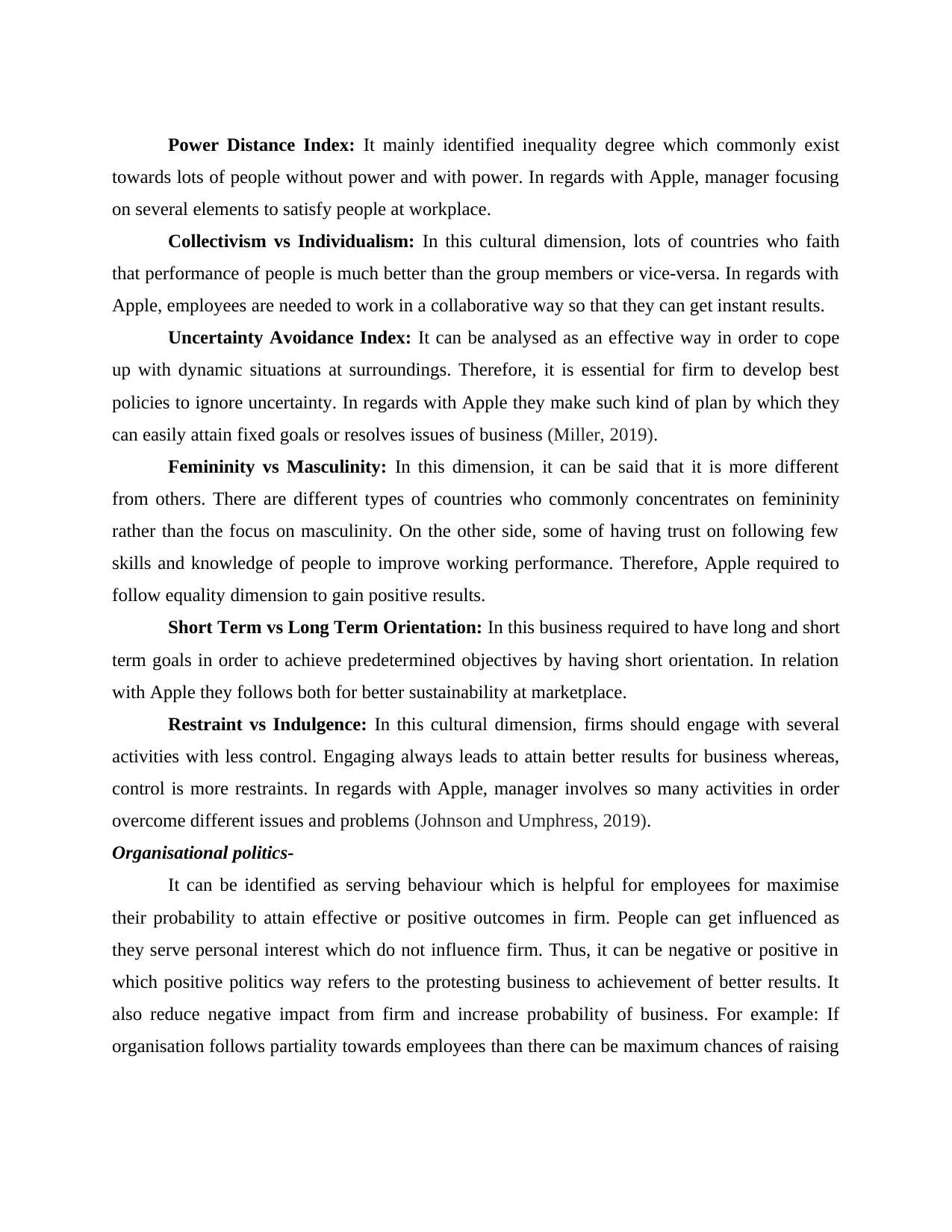
Power Distance Index: It mainly identified inequality degree which commonly exist
towards lots of people without power and with power. In regards with Apple, manager focusing
on several elements to satisfy people at workplace.
Collectivism vs Individualism: In this cultural dimension, lots of countries who faith
that performance of people is much better than the group members or vice-versa. In regards with
Apple, employees are needed to work in a collaborative way so that they can get instant results.
Uncertainty Avoidance Index: It can be analysed as an effective way in order to cope
up with dynamic situations at surroundings. Therefore, it is essential for firm to develop best
policies to ignore uncertainty. In regards with Apple they make such kind of plan by which they
can easily attain fixed goals or resolves issues of business (Miller, 2019).
Femininity vs Masculinity: In this dimension, it can be said that it is more different
from others. There are different types of countries who commonly concentrates on femininity
rather than the focus on masculinity. On the other side, some of having trust on following few
skills and knowledge of people to improve working performance. Therefore, Apple required to
follow equality dimension to gain positive results.
Short Term vs Long Term Orientation: In this business required to have long and short
term goals in order to achieve predetermined objectives by having short orientation. In relation
with Apple they follows both for better sustainability at marketplace.
Restraint vs Indulgence: In this cultural dimension, firms should engage with several
activities with less control. Engaging always leads to attain better results for business whereas,
control is more restraints. In regards with Apple, manager involves so many activities in order
overcome different issues and problems (Johnson and Umphress, 2019).
Organisational politics-
It can be identified as serving behaviour which is helpful for employees for maximise
their probability to attain effective or positive outcomes in firm. People can get influenced as
they serve personal interest which do not influence firm. Thus, it can be negative or positive in
which positive politics way refers to the protesting business to achievement of better results. It
also reduce negative impact from firm and increase probability of business. For example: If
organisation follows partiality towards employees than there can be maximum chances of raising
towards lots of people without power and with power. In regards with Apple, manager focusing
on several elements to satisfy people at workplace.
Collectivism vs Individualism: In this cultural dimension, lots of countries who faith
that performance of people is much better than the group members or vice-versa. In regards with
Apple, employees are needed to work in a collaborative way so that they can get instant results.
Uncertainty Avoidance Index: It can be analysed as an effective way in order to cope
up with dynamic situations at surroundings. Therefore, it is essential for firm to develop best
policies to ignore uncertainty. In regards with Apple they make such kind of plan by which they
can easily attain fixed goals or resolves issues of business (Miller, 2019).
Femininity vs Masculinity: In this dimension, it can be said that it is more different
from others. There are different types of countries who commonly concentrates on femininity
rather than the focus on masculinity. On the other side, some of having trust on following few
skills and knowledge of people to improve working performance. Therefore, Apple required to
follow equality dimension to gain positive results.
Short Term vs Long Term Orientation: In this business required to have long and short
term goals in order to achieve predetermined objectives by having short orientation. In relation
with Apple they follows both for better sustainability at marketplace.
Restraint vs Indulgence: In this cultural dimension, firms should engage with several
activities with less control. Engaging always leads to attain better results for business whereas,
control is more restraints. In regards with Apple, manager involves so many activities in order
overcome different issues and problems (Johnson and Umphress, 2019).
Organisational politics-
It can be identified as serving behaviour which is helpful for employees for maximise
their probability to attain effective or positive outcomes in firm. People can get influenced as
they serve personal interest which do not influence firm. Thus, it can be negative or positive in
which positive politics way refers to the protesting business to achievement of better results. It
also reduce negative impact from firm and increase probability of business. For example: If
organisation follows partiality towards employees than there can be maximum chances of raising
Paraphrase This Document
Need a fresh take? Get an instant paraphrase of this document with our AI Paraphraser
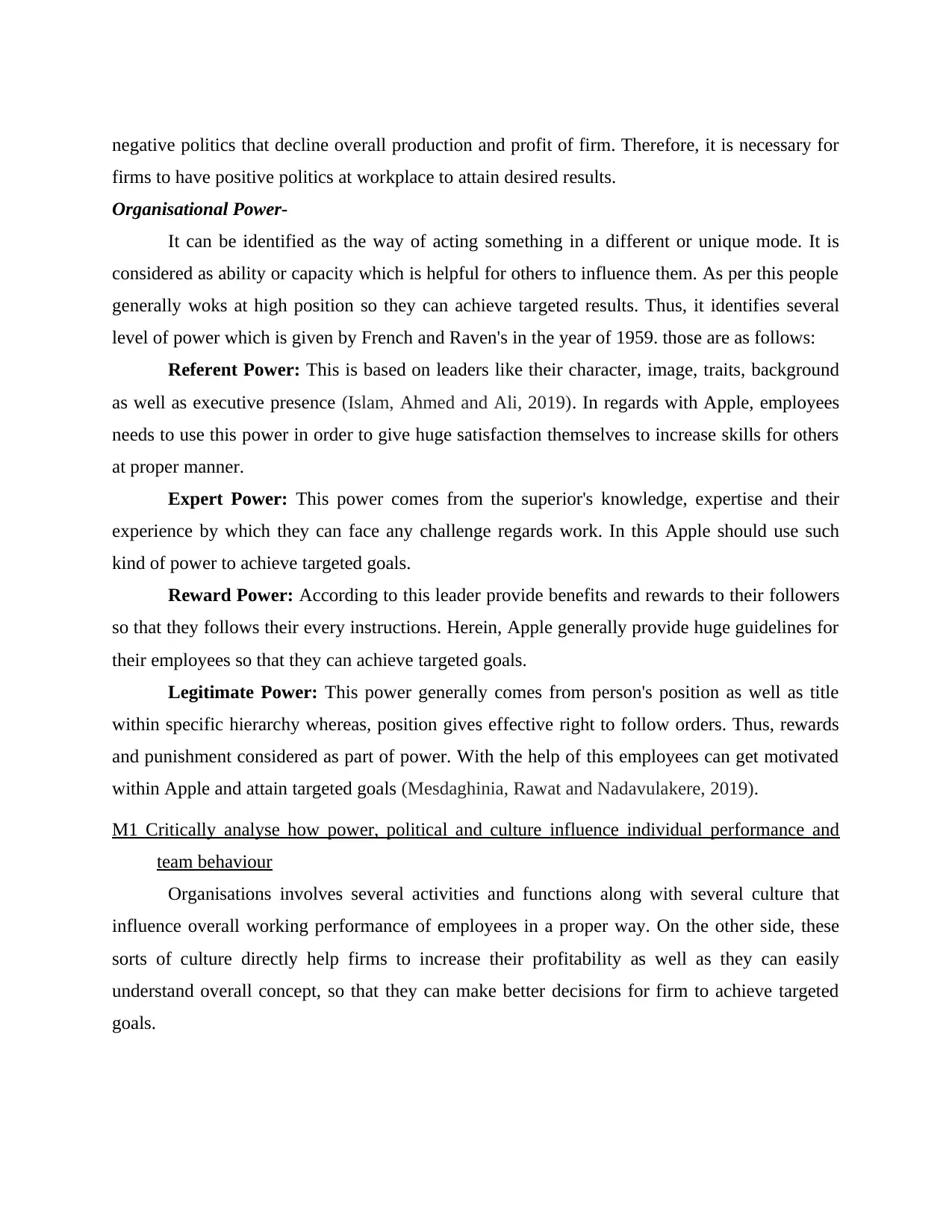
negative politics that decline overall production and profit of firm. Therefore, it is necessary for
firms to have positive politics at workplace to attain desired results.
Organisational Power-
It can be identified as the way of acting something in a different or unique mode. It is
considered as ability or capacity which is helpful for others to influence them. As per this people
generally woks at high position so they can achieve targeted results. Thus, it identifies several
level of power which is given by French and Raven's in the year of 1959. those are as follows:
Referent Power: This is based on leaders like their character, image, traits, background
as well as executive presence (Islam, Ahmed and Ali, 2019). In regards with Apple, employees
needs to use this power in order to give huge satisfaction themselves to increase skills for others
at proper manner.
Expert Power: This power comes from the superior's knowledge, expertise and their
experience by which they can face any challenge regards work. In this Apple should use such
kind of power to achieve targeted goals.
Reward Power: According to this leader provide benefits and rewards to their followers
so that they follows their every instructions. Herein, Apple generally provide huge guidelines for
their employees so that they can achieve targeted goals.
Legitimate Power: This power generally comes from person's position as well as title
within specific hierarchy whereas, position gives effective right to follow orders. Thus, rewards
and punishment considered as part of power. With the help of this employees can get motivated
within Apple and attain targeted goals (Mesdaghinia, Rawat and Nadavulakere, 2019).
M1 Critically analyse how power, political and culture influence individual performance and
team behaviour
Organisations involves several activities and functions along with several culture that
influence overall working performance of employees in a proper way. On the other side, these
sorts of culture directly help firms to increase their profitability as well as they can easily
understand overall concept, so that they can make better decisions for firm to achieve targeted
goals.
firms to have positive politics at workplace to attain desired results.
Organisational Power-
It can be identified as the way of acting something in a different or unique mode. It is
considered as ability or capacity which is helpful for others to influence them. As per this people
generally woks at high position so they can achieve targeted results. Thus, it identifies several
level of power which is given by French and Raven's in the year of 1959. those are as follows:
Referent Power: This is based on leaders like their character, image, traits, background
as well as executive presence (Islam, Ahmed and Ali, 2019). In regards with Apple, employees
needs to use this power in order to give huge satisfaction themselves to increase skills for others
at proper manner.
Expert Power: This power comes from the superior's knowledge, expertise and their
experience by which they can face any challenge regards work. In this Apple should use such
kind of power to achieve targeted goals.
Reward Power: According to this leader provide benefits and rewards to their followers
so that they follows their every instructions. Herein, Apple generally provide huge guidelines for
their employees so that they can achieve targeted goals.
Legitimate Power: This power generally comes from person's position as well as title
within specific hierarchy whereas, position gives effective right to follow orders. Thus, rewards
and punishment considered as part of power. With the help of this employees can get motivated
within Apple and attain targeted goals (Mesdaghinia, Rawat and Nadavulakere, 2019).
M1 Critically analyse how power, political and culture influence individual performance and
team behaviour
Organisations involves several activities and functions along with several culture that
influence overall working performance of employees in a proper way. On the other side, these
sorts of culture directly help firms to increase their profitability as well as they can easily
understand overall concept, so that they can make better decisions for firm to achieve targeted
goals.
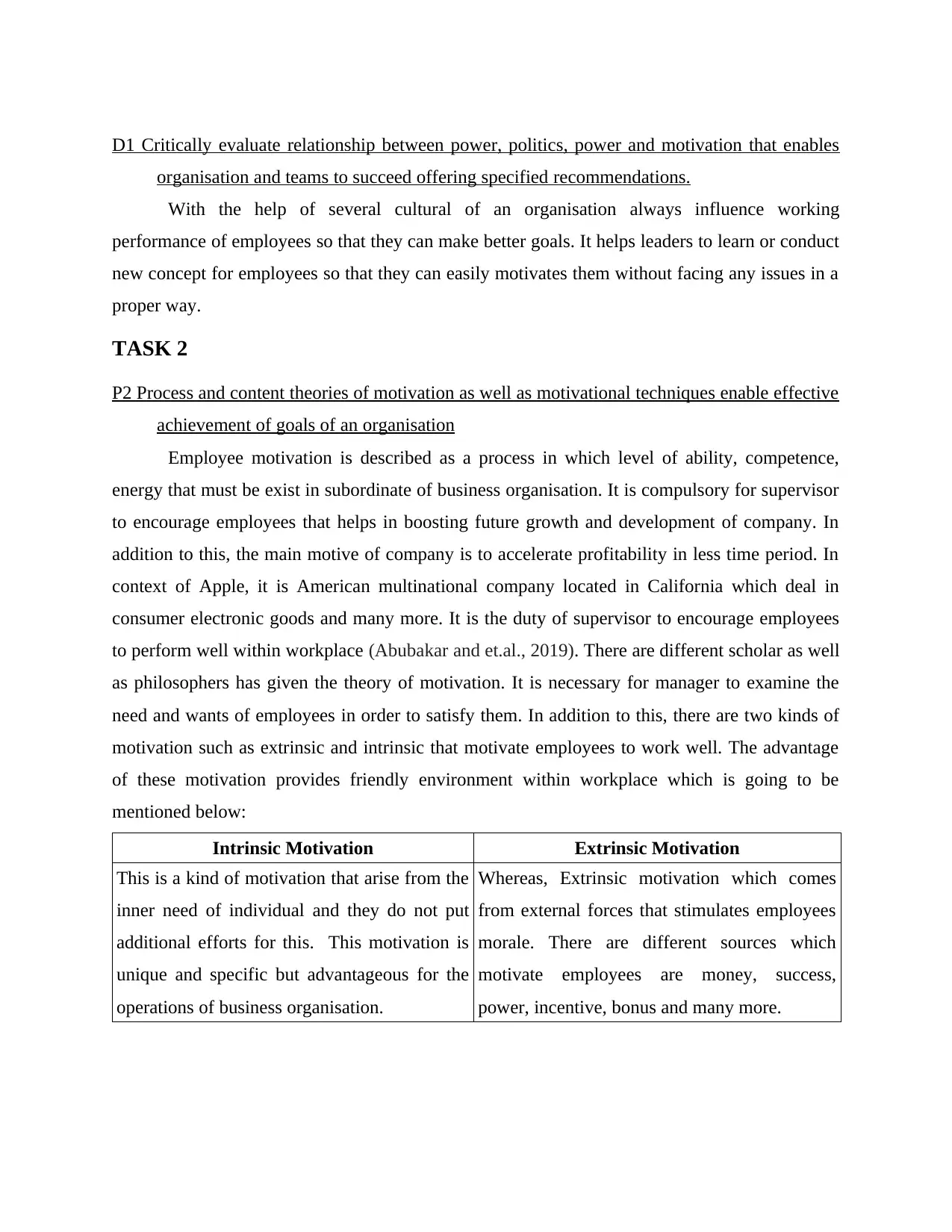
D1 Critically evaluate relationship between power, politics, power and motivation that enables
organisation and teams to succeed offering specified recommendations.
With the help of several cultural of an organisation always influence working
performance of employees so that they can make better goals. It helps leaders to learn or conduct
new concept for employees so that they can easily motivates them without facing any issues in a
proper way.
TASK 2
P2 Process and content theories of motivation as well as motivational techniques enable effective
achievement of goals of an organisation
Employee motivation is described as a process in which level of ability, competence,
energy that must be exist in subordinate of business organisation. It is compulsory for supervisor
to encourage employees that helps in boosting future growth and development of company. In
addition to this, the main motive of company is to accelerate profitability in less time period. In
context of Apple, it is American multinational company located in California which deal in
consumer electronic goods and many more. It is the duty of supervisor to encourage employees
to perform well within workplace (Abubakar and et.al., 2019). There are different scholar as well
as philosophers has given the theory of motivation. It is necessary for manager to examine the
need and wants of employees in order to satisfy them. In addition to this, there are two kinds of
motivation such as extrinsic and intrinsic that motivate employees to work well. The advantage
of these motivation provides friendly environment within workplace which is going to be
mentioned below:
Intrinsic Motivation Extrinsic Motivation
This is a kind of motivation that arise from the
inner need of individual and they do not put
additional efforts for this. This motivation is
unique and specific but advantageous for the
operations of business organisation.
Whereas, Extrinsic motivation which comes
from external forces that stimulates employees
morale. There are different sources which
motivate employees are money, success,
power, incentive, bonus and many more.
organisation and teams to succeed offering specified recommendations.
With the help of several cultural of an organisation always influence working
performance of employees so that they can make better goals. It helps leaders to learn or conduct
new concept for employees so that they can easily motivates them without facing any issues in a
proper way.
TASK 2
P2 Process and content theories of motivation as well as motivational techniques enable effective
achievement of goals of an organisation
Employee motivation is described as a process in which level of ability, competence,
energy that must be exist in subordinate of business organisation. It is compulsory for supervisor
to encourage employees that helps in boosting future growth and development of company. In
addition to this, the main motive of company is to accelerate profitability in less time period. In
context of Apple, it is American multinational company located in California which deal in
consumer electronic goods and many more. It is the duty of supervisor to encourage employees
to perform well within workplace (Abubakar and et.al., 2019). There are different scholar as well
as philosophers has given the theory of motivation. It is necessary for manager to examine the
need and wants of employees in order to satisfy them. In addition to this, there are two kinds of
motivation such as extrinsic and intrinsic that motivate employees to work well. The advantage
of these motivation provides friendly environment within workplace which is going to be
mentioned below:
Intrinsic Motivation Extrinsic Motivation
This is a kind of motivation that arise from the
inner need of individual and they do not put
additional efforts for this. This motivation is
unique and specific but advantageous for the
operations of business organisation.
Whereas, Extrinsic motivation which comes
from external forces that stimulates employees
morale. There are different sources which
motivate employees are money, success,
power, incentive, bonus and many more.
⊘ This is a preview!⊘
Do you want full access?
Subscribe today to unlock all pages.

Trusted by 1+ million students worldwide
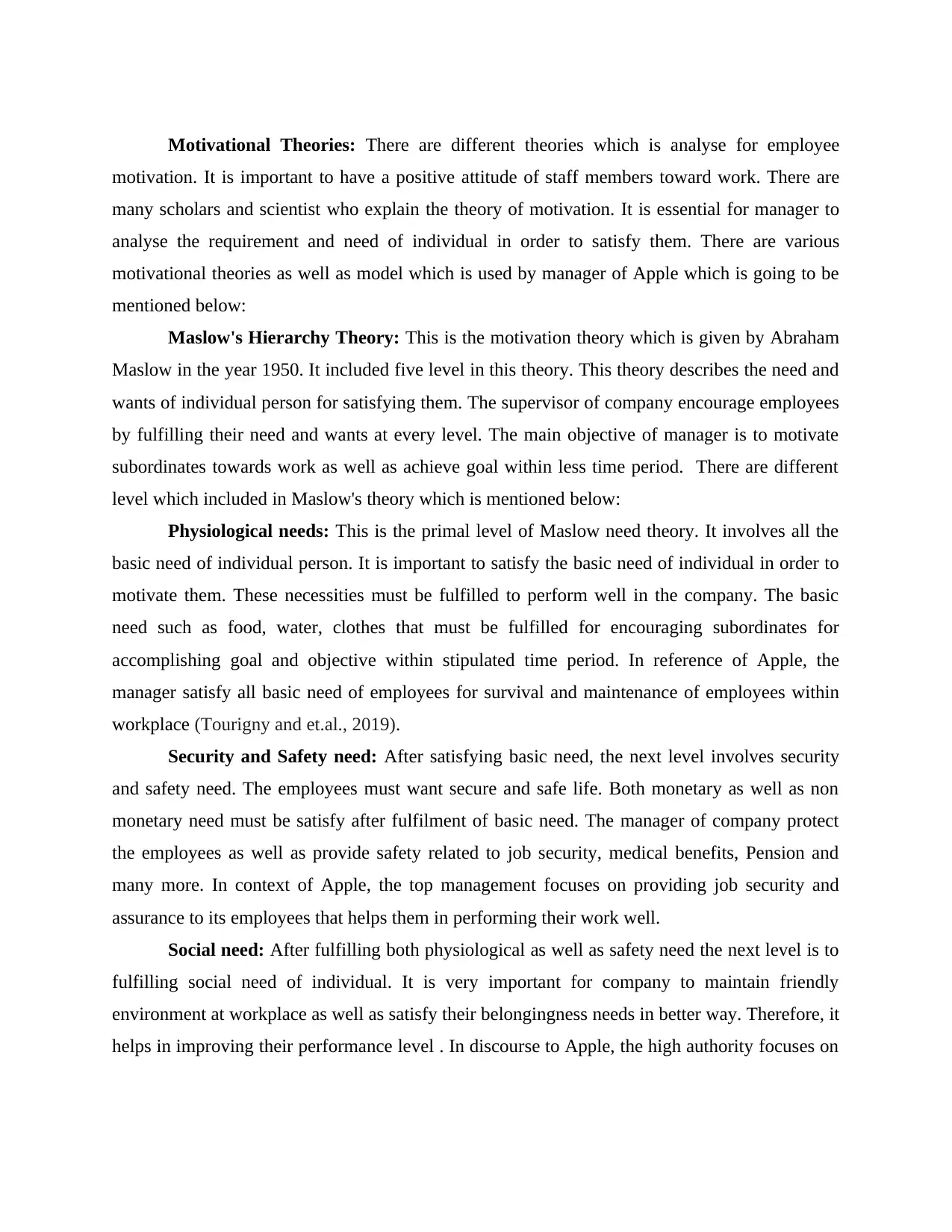
Motivational Theories: There are different theories which is analyse for employee
motivation. It is important to have a positive attitude of staff members toward work. There are
many scholars and scientist who explain the theory of motivation. It is essential for manager to
analyse the requirement and need of individual in order to satisfy them. There are various
motivational theories as well as model which is used by manager of Apple which is going to be
mentioned below:
Maslow's Hierarchy Theory: This is the motivation theory which is given by Abraham
Maslow in the year 1950. It included five level in this theory. This theory describes the need and
wants of individual person for satisfying them. The supervisor of company encourage employees
by fulfilling their need and wants at every level. The main objective of manager is to motivate
subordinates towards work as well as achieve goal within less time period. There are different
level which included in Maslow's theory which is mentioned below:
Physiological needs: This is the primal level of Maslow need theory. It involves all the
basic need of individual person. It is important to satisfy the basic need of individual in order to
motivate them. These necessities must be fulfilled to perform well in the company. The basic
need such as food, water, clothes that must be fulfilled for encouraging subordinates for
accomplishing goal and objective within stipulated time period. In reference of Apple, the
manager satisfy all basic need of employees for survival and maintenance of employees within
workplace (Tourigny and et.al., 2019).
Security and Safety need: After satisfying basic need, the next level involves security
and safety need. The employees must want secure and safe life. Both monetary as well as non
monetary need must be satisfy after fulfilment of basic need. The manager of company protect
the employees as well as provide safety related to job security, medical benefits, Pension and
many more. In context of Apple, the top management focuses on providing job security and
assurance to its employees that helps them in performing their work well.
Social need: After fulfilling both physiological as well as safety need the next level is to
fulfilling social need of individual. It is very important for company to maintain friendly
environment at workplace as well as satisfy their belongingness needs in better way. Therefore, it
helps in improving their performance level . In discourse to Apple, the high authority focuses on
motivation. It is important to have a positive attitude of staff members toward work. There are
many scholars and scientist who explain the theory of motivation. It is essential for manager to
analyse the requirement and need of individual in order to satisfy them. There are various
motivational theories as well as model which is used by manager of Apple which is going to be
mentioned below:
Maslow's Hierarchy Theory: This is the motivation theory which is given by Abraham
Maslow in the year 1950. It included five level in this theory. This theory describes the need and
wants of individual person for satisfying them. The supervisor of company encourage employees
by fulfilling their need and wants at every level. The main objective of manager is to motivate
subordinates towards work as well as achieve goal within less time period. There are different
level which included in Maslow's theory which is mentioned below:
Physiological needs: This is the primal level of Maslow need theory. It involves all the
basic need of individual person. It is important to satisfy the basic need of individual in order to
motivate them. These necessities must be fulfilled to perform well in the company. The basic
need such as food, water, clothes that must be fulfilled for encouraging subordinates for
accomplishing goal and objective within stipulated time period. In reference of Apple, the
manager satisfy all basic need of employees for survival and maintenance of employees within
workplace (Tourigny and et.al., 2019).
Security and Safety need: After satisfying basic need, the next level involves security
and safety need. The employees must want secure and safe life. Both monetary as well as non
monetary need must be satisfy after fulfilment of basic need. The manager of company protect
the employees as well as provide safety related to job security, medical benefits, Pension and
many more. In context of Apple, the top management focuses on providing job security and
assurance to its employees that helps them in performing their work well.
Social need: After fulfilling both physiological as well as safety need the next level is to
fulfilling social need of individual. It is very important for company to maintain friendly
environment at workplace as well as satisfy their belongingness needs in better way. Therefore, it
helps in improving their performance level . In discourse to Apple, the high authority focuses on
Paraphrase This Document
Need a fresh take? Get an instant paraphrase of this document with our AI Paraphraser
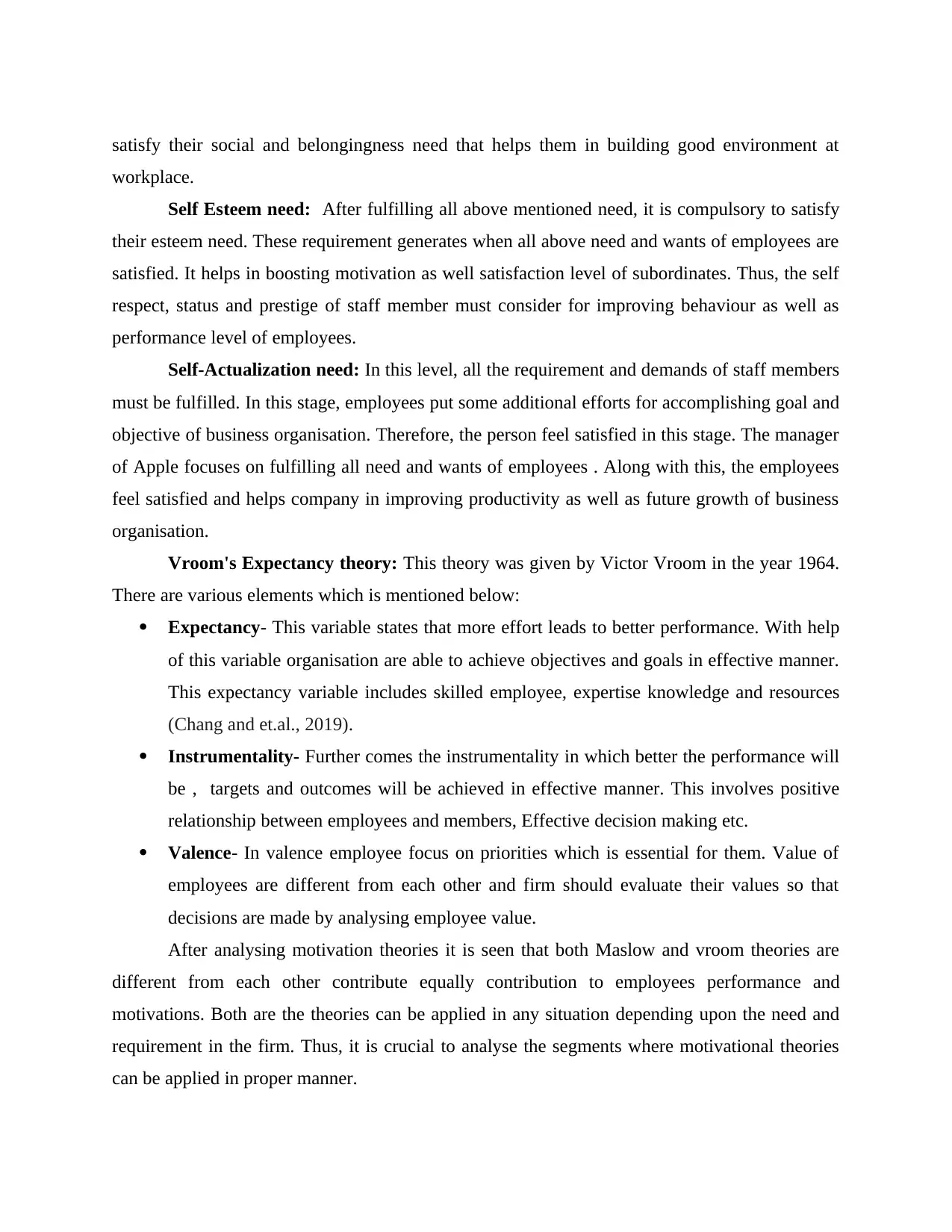
satisfy their social and belongingness need that helps them in building good environment at
workplace.
Self Esteem need: After fulfilling all above mentioned need, it is compulsory to satisfy
their esteem need. These requirement generates when all above need and wants of employees are
satisfied. It helps in boosting motivation as well satisfaction level of subordinates. Thus, the self
respect, status and prestige of staff member must consider for improving behaviour as well as
performance level of employees.
Self-Actualization need: In this level, all the requirement and demands of staff members
must be fulfilled. In this stage, employees put some additional efforts for accomplishing goal and
objective of business organisation. Therefore, the person feel satisfied in this stage. The manager
of Apple focuses on fulfilling all need and wants of employees . Along with this, the employees
feel satisfied and helps company in improving productivity as well as future growth of business
organisation.
Vroom's Expectancy theory: This theory was given by Victor Vroom in the year 1964.
There are various elements which is mentioned below:
Expectancy- This variable states that more effort leads to better performance. With help
of this variable organisation are able to achieve objectives and goals in effective manner.
This expectancy variable includes skilled employee, expertise knowledge and resources
(Chang and et.al., 2019).
Instrumentality- Further comes the instrumentality in which better the performance will
be , targets and outcomes will be achieved in effective manner. This involves positive
relationship between employees and members, Effective decision making etc.
Valence- In valence employee focus on priorities which is essential for them. Value of
employees are different from each other and firm should evaluate their values so that
decisions are made by analysing employee value.
After analysing motivation theories it is seen that both Maslow and vroom theories are
different from each other contribute equally contribution to employees performance and
motivations. Both are the theories can be applied in any situation depending upon the need and
requirement in the firm. Thus, it is crucial to analyse the segments where motivational theories
can be applied in proper manner.
workplace.
Self Esteem need: After fulfilling all above mentioned need, it is compulsory to satisfy
their esteem need. These requirement generates when all above need and wants of employees are
satisfied. It helps in boosting motivation as well satisfaction level of subordinates. Thus, the self
respect, status and prestige of staff member must consider for improving behaviour as well as
performance level of employees.
Self-Actualization need: In this level, all the requirement and demands of staff members
must be fulfilled. In this stage, employees put some additional efforts for accomplishing goal and
objective of business organisation. Therefore, the person feel satisfied in this stage. The manager
of Apple focuses on fulfilling all need and wants of employees . Along with this, the employees
feel satisfied and helps company in improving productivity as well as future growth of business
organisation.
Vroom's Expectancy theory: This theory was given by Victor Vroom in the year 1964.
There are various elements which is mentioned below:
Expectancy- This variable states that more effort leads to better performance. With help
of this variable organisation are able to achieve objectives and goals in effective manner.
This expectancy variable includes skilled employee, expertise knowledge and resources
(Chang and et.al., 2019).
Instrumentality- Further comes the instrumentality in which better the performance will
be , targets and outcomes will be achieved in effective manner. This involves positive
relationship between employees and members, Effective decision making etc.
Valence- In valence employee focus on priorities which is essential for them. Value of
employees are different from each other and firm should evaluate their values so that
decisions are made by analysing employee value.
After analysing motivation theories it is seen that both Maslow and vroom theories are
different from each other contribute equally contribution to employees performance and
motivations. Both are the theories can be applied in any situation depending upon the need and
requirement in the firm. Thus, it is crucial to analyse the segments where motivational theories
can be applied in proper manner.
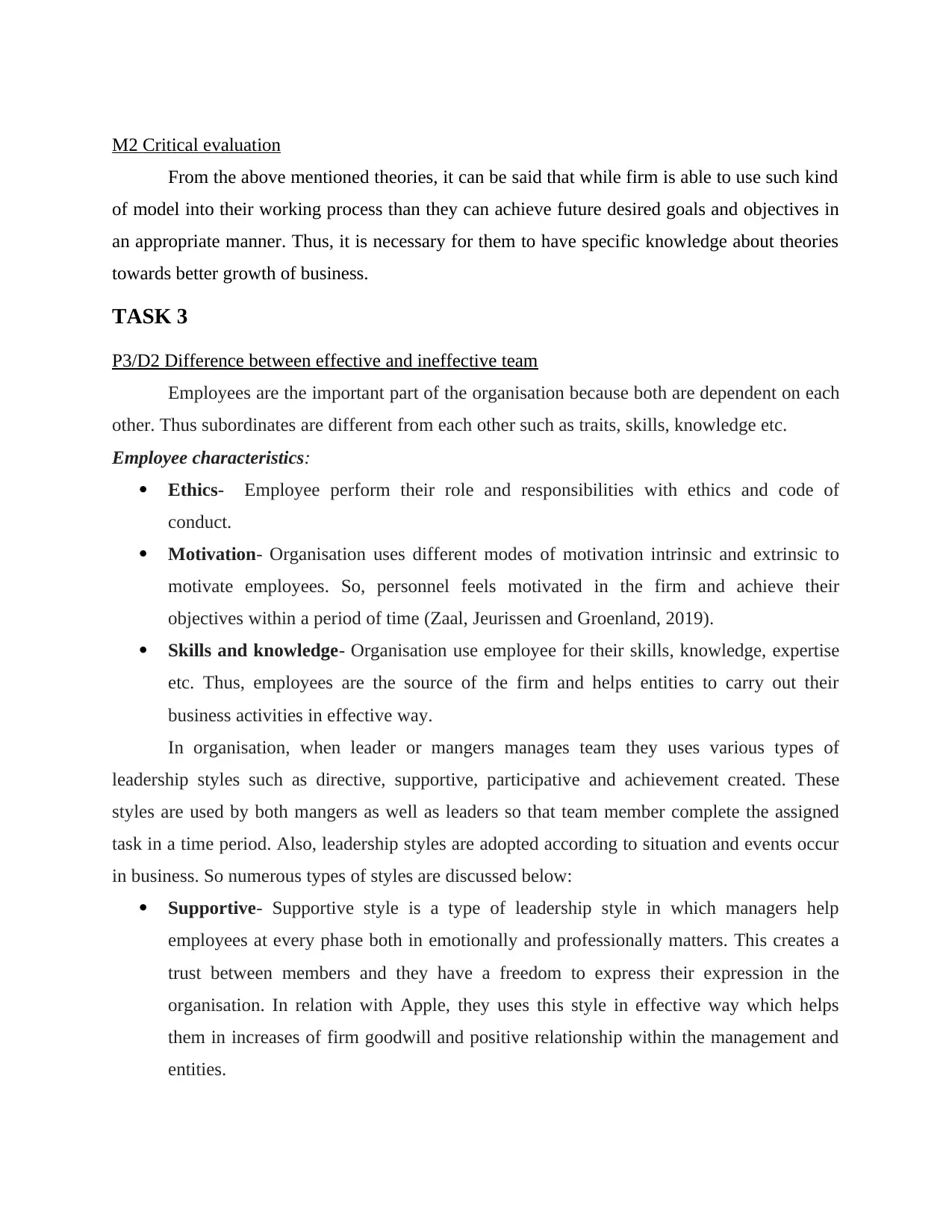
M2 Critical evaluation
From the above mentioned theories, it can be said that while firm is able to use such kind
of model into their working process than they can achieve future desired goals and objectives in
an appropriate manner. Thus, it is necessary for them to have specific knowledge about theories
towards better growth of business.
TASK 3
P3/D2 Difference between effective and ineffective team
Employees are the important part of the organisation because both are dependent on each
other. Thus subordinates are different from each other such as traits, skills, knowledge etc.
Employee characteristics:
Ethics- Employee perform their role and responsibilities with ethics and code of
conduct.
Motivation- Organisation uses different modes of motivation intrinsic and extrinsic to
motivate employees. So, personnel feels motivated in the firm and achieve their
objectives within a period of time (Zaal, Jeurissen and Groenland, 2019).
Skills and knowledge- Organisation use employee for their skills, knowledge, expertise
etc. Thus, employees are the source of the firm and helps entities to carry out their
business activities in effective way.
In organisation, when leader or mangers manages team they uses various types of
leadership styles such as directive, supportive, participative and achievement created. These
styles are used by both mangers as well as leaders so that team member complete the assigned
task in a time period. Also, leadership styles are adopted according to situation and events occur
in business. So numerous types of styles are discussed below:
Supportive- Supportive style is a type of leadership style in which managers help
employees at every phase both in emotionally and professionally matters. This creates a
trust between members and they have a freedom to express their expression in the
organisation. In relation with Apple, they uses this style in effective way which helps
them in increases of firm goodwill and positive relationship within the management and
entities.
From the above mentioned theories, it can be said that while firm is able to use such kind
of model into their working process than they can achieve future desired goals and objectives in
an appropriate manner. Thus, it is necessary for them to have specific knowledge about theories
towards better growth of business.
TASK 3
P3/D2 Difference between effective and ineffective team
Employees are the important part of the organisation because both are dependent on each
other. Thus subordinates are different from each other such as traits, skills, knowledge etc.
Employee characteristics:
Ethics- Employee perform their role and responsibilities with ethics and code of
conduct.
Motivation- Organisation uses different modes of motivation intrinsic and extrinsic to
motivate employees. So, personnel feels motivated in the firm and achieve their
objectives within a period of time (Zaal, Jeurissen and Groenland, 2019).
Skills and knowledge- Organisation use employee for their skills, knowledge, expertise
etc. Thus, employees are the source of the firm and helps entities to carry out their
business activities in effective way.
In organisation, when leader or mangers manages team they uses various types of
leadership styles such as directive, supportive, participative and achievement created. These
styles are used by both mangers as well as leaders so that team member complete the assigned
task in a time period. Also, leadership styles are adopted according to situation and events occur
in business. So numerous types of styles are discussed below:
Supportive- Supportive style is a type of leadership style in which managers help
employees at every phase both in emotionally and professionally matters. This creates a
trust between members and they have a freedom to express their expression in the
organisation. In relation with Apple, they uses this style in effective way which helps
them in increases of firm goodwill and positive relationship within the management and
entities.
⊘ This is a preview!⊘
Do you want full access?
Subscribe today to unlock all pages.

Trusted by 1+ million students worldwide
1 out of 18
Related Documents
Your All-in-One AI-Powered Toolkit for Academic Success.
+13062052269
info@desklib.com
Available 24*7 on WhatsApp / Email
![[object Object]](/_next/static/media/star-bottom.7253800d.svg)
Unlock your academic potential
Copyright © 2020–2025 A2Z Services. All Rights Reserved. Developed and managed by ZUCOL.




